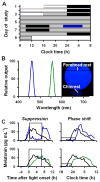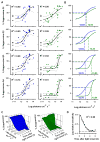Spectral responses of the human circadian system depend on the irradiance and duration of exposure to light
- PMID: 20463367
- PMCID: PMC4414925
- DOI: 10.1126/scitranslmed.3000741
Spectral responses of the human circadian system depend on the irradiance and duration of exposure to light
Abstract
In humans, modulation of circadian rhythms by light is thought to be mediated primarily by melanopsin-containing retinal ganglion cells, not rods or cones. Melanopsin cells are intrinsically blue light-sensitive but also receive input from visual photoreceptors. We therefore tested in humans whether cone photoreceptors contribute to the regulation of circadian and neuroendocrine light responses. Dose-response curves for melatonin suppression and circadian phase resetting were constructed in subjects exposed to blue (460 nm) or green (555 nm) light near the onset of nocturnal melatonin secretion. At the beginning of the intervention, 555-nm light was equally effective as 460-nm light at suppressing melatonin, suggesting a significant contribution from the three-cone visual system (lambda(max) = 555 nm). During the light exposure, however, the spectral sensitivity to 555-nm light decayed exponentially relative to 460-nm light. For phase-resetting responses, the effects of exposure to low-irradiance 555-nm light were too large relative to 460-nm light to be explained solely by the activation of melanopsin. Our findings suggest that cone photoreceptors contribute substantially to nonvisual responses at the beginning of a light exposure and at low irradiances, whereas melanopsin appears to be the primary circadian photopigment in response to long-duration light exposure and at high irradiances. These results suggest that light therapy for sleep disorders and other indications might be optimized by stimulating both photoreceptor systems.
Figures



Similar articles
-
The spectral sensitivity of human circadian phase resetting and melatonin suppression to light changes dynamically with light duration.Proc Natl Acad Sci U S A. 2022 Dec 20;119(51):e2205301119. doi: 10.1073/pnas.2205301119. Epub 2022 Dec 12. Proc Natl Acad Sci U S A. 2022. PMID: 36508661 Free PMC article.
-
An action spectrum for melatonin suppression: evidence for a novel non-rod, non-cone photoreceptor system in humans.J Physiol. 2001 Aug 15;535(Pt 1):261-7. doi: 10.1111/j.1469-7793.2001.t01-1-00261.x. J Physiol. 2001. PMID: 11507175 Free PMC article.
-
Modeling the role of mid-wavelength cones in circadian responses to light.Neuron. 2007 Mar 1;53(5):677-87. doi: 10.1016/j.neuron.2007.02.005. Neuron. 2007. PMID: 17329208 Free PMC article.
-
Diverse types of ganglion cell photoreceptors in the mammalian retina.Prog Retin Eye Res. 2012 Jul;31(4):287-302. doi: 10.1016/j.preteyeres.2012.03.003. Epub 2012 Mar 26. Prog Retin Eye Res. 2012. PMID: 22480975 Free PMC article. Review.
-
Multiple photoreceptors contribute to nonimage-forming visual functions predominantly through melanopsin-containing retinal ganglion cells.Cold Spring Harb Symp Quant Biol. 2007;72:509-15. doi: 10.1101/sqb.2007.72.074. Cold Spring Harb Symp Quant Biol. 2007. PMID: 18522518 Review.
Cited by
-
The Lighting Environment, Its Metrology, and Non-visual Responses.Front Neurol. 2021 Mar 4;12:624861. doi: 10.3389/fneur.2021.624861. eCollection 2021. Front Neurol. 2021. PMID: 33746879 Free PMC article.
-
Human responses to bright light of different durations.J Physiol. 2012 Jul 1;590(13):3103-12. doi: 10.1113/jphysiol.2011.226555. Epub 2012 Apr 23. J Physiol. 2012. PMID: 22526883 Free PMC article. Clinical Trial.
-
Are short (blue) wavelengths necessary for light treatment of seasonal affective disorder?Chronobiol Int. 2016;33(9):1267-1279. doi: 10.1080/07420528.2016.1207660. Epub 2016 Aug 5. Chronobiol Int. 2016. PMID: 27494399 Free PMC article.
-
Using light to tell the time of day: sensory coding in the mammalian circadian visual network.J Exp Biol. 2016 Jun 15;219(Pt 12):1779-92. doi: 10.1242/jeb.132167. J Exp Biol. 2016. PMID: 27307539 Free PMC article. Review.
-
Effects of dynamic lighting on circadian phase, self-reported sleep and performance during a 45-day space analog mission with chronic variable sleep deficiency.J Pineal Res. 2022 Nov;73(4):e12826. doi: 10.1111/jpi.12826. Epub 2022 Sep 5. J Pineal Res. 2022. PMID: 35996978 Free PMC article.
References
-
- Czeisler CA, Shanahan TL, Klerman EB, Martens H, Brotman DJ, Emens JS, Klein T, Rizzo JF., III Suppression of melatonin secretion in some blind patients by exposure to bright light. N Engl J Med. 1995;332:6–11. - PubMed
-
- Klerman EB, Shanahan TL, Brotman DJ, Rimmer DW, Emens JS, Rizzo JF, III, Czeisler CA. Photic resetting of the human circadian pacemaker in the absence of conscious vision. J Biol Rhythms. 2002;17:548–555. - PubMed
-
- Ruberg FL, Skene DJ, Hanifin JP, Rollag MD, English J, Arendt J, Brainard GC. Melatonin regulation in humans with color vision deficiencies. J Clin Endocrinol Metab. 1996;81:2980–2985. - PubMed
-
- Zaidi FH, Hull JT, Peirson SN, Wulff K, Aeschbach D, Gooley JJ, Brainard GC, Gregory-Evans K, Rizzo JF, III, Czeisler CA, Foster RG, Moseley MJ, Lockley SW. Short-wavelength light sensitivity of circadian, pupillary, and visual awareness in humans lacking an outer retina. Curr Biol. 2007;17:2122–2128. - PMC - PubMed
Publication types
MeSH terms
Substances
Grants and funding
LinkOut - more resources
Full Text Sources
Other Literature Sources

